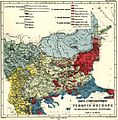Ottoman rule
Main article: Ottoman Albania
Ottoman supremacy in the west Balkan region began in 1385 with the Battle of Savra. On the conquered part of Albania, which territory stretched between Mat River on the north andÇameria to the south, Ottoman Empire established the Sanjak of Albania [36] and in 1419 Gjirokastra became the county town of the Sanjak of Albania.[37] Beginning in the late-14th century, the Ottomans expanded their empire from Anatolia to the Balkans (Rumelia). By the 15th century, the Ottomans ruled most of the Balkan Peninsula. Their rule in part of Albaniawas briefly interrupted in the 15th century, when George Kastrioti Skanderbeg, an Albanian who had served as an Ottoman military officer, renounced Ottoman service, allied with some Albanian chiefs and fought off Turkish rule from 1443-1478. Albania was fully re-occupied by the Ottomans in 1478.
[edit]Ottoman-Albanian wars
Many Albanians had been recruited into the Janissary, including the feudal heir George Kastrioti who was renamed Skanderbeg (Iskandar Bey) by his Turkish trainers at Edirne. After some Ottoman defeats at the hands of the Serbs, Skanderbeg deserted and began a rebellion against theOttoman Empire.[38]
After deserting, Skanderbeg re-converted to Roman Catholicism and declared a holy war against the Ottoman Empire,[38] which he led from 1443 to 1468. Under a red flag bearing Skanderbeg's heraldic emblem, an Albanian force held off Ottoman campaigns for twenty-five years and overcame sieges of Krujë led by the forces of the Ottoman sultans Murad II and Mehmed II.
However, Skanderbeg was unable to receive any of the help which had been promised him by the popes. He died in 1468, leaving no worthy successor. After his death the rebellion continued, but without its former success. The loyalties and alliances created and nurtured by Skanderbeg faltered and fell apart and the Ottomans reconquered the territory of Albania in 1478. Shortly after the fall of Kruje's castle, some Albanians fled to neighboring Italy, giving rise to the modern Arbëreshë communities.
[edit]Late Ottoman period
Upon the Ottomans' return in 1478, a large number of Albanians fled to Italy, Greece and Egypt and maintained their Arbëresh identity. Many Albanians won fame and fortune as soldiers, administrators, and merchants in far-flung parts of the Empire. As the centuries passed, however, Ottoman rulers lost the capacity to command the loyalty of local pashas, which threatened stability in the region. The Ottoman rulers of the 19th century struggled to shore up central authority, introducing reforms aimed at harnessing unruly pashas and checking the spread of nationalist ideas. Albaniawould be a part of the Ottoman Empire until the early 20th century.
The Ottoman period that followed was characterized by a change in the landscape through a gradual modification of the settlements with the introduction of bazaars, military garrisons and mosques in many Albanian regions. Part of the Albanian population gradually converted to Islam, with many joining the Sufi Order of the Bektashi. Converting from Christianity to Islam brought considerable advantages, including access to Ottoman trade networks, bureaucratic positions and the army. As a result many Albanians came to serve in the elite Janissary and the administrative Devşirme system. Among these were important historical figures, including Iljaz Hoxha, Hamza Kastrioti, Davud Pasha, Zağanos Pasha, Köprülü Mehmed Pasha (head of the Köprülü family of Grand Viziers), the Bushati family, Sulejman Pasha, Edhem Pasha, Nezim Frakulla, Ali Pasha of Tepelena, Haxhi Shekreti, Hasan Zyko Kamberi, Ali Pasha of Gucia, Mehmet Ali ruler of Egypt[39] and Emin Pasha[citation needed].
Many Albanians gained prominent positions in the Ottoman government, Albanians highly active during the Ottoman era and leaders such as Ali Pasha of Tepelena might have aided Husein Gradaščević. The Albanians proved generally faithful to Ottoman rule following the end of the resistance led by Skanderbeg, and accepted Islam more easily than their neighbors.[40] No fewer than 42 Grand Viziers of the Empire were of Albanian descent. The Ottoman period also saw the rising of semi-autonomous Albanian ruled Pashaliks and Albanians were also an important part of the Ottoman army and Ottoman administration like the case of Köprülü family. Albania would remain a part of the Ottoman Empire as the provinces of Scutari, Monastir and Janina until 1912.
[edit]Birth of nationalism
Main articles: National awakening and the birth of Albania and League of Prizren
Further information: Albanian nationalism and Albanian Revolt of 1910
By the 1870s, the Sublime Porte's reforms aimed at checking the Ottoman Empire's disintegration had clearly failed. The image of the "Turkish yoke" had become fixed in the nationalist mythologies and psyches of the empire's Balkan peoples, and their march toward independence quickened. TheAlbanians, because of the higher degree of Islamic influence, their internal social divisions, and the fear that they would lose their Albanian-populated lands to the emerging Balkan states—Serbia, Montenegro, Bulgaria, and Greece—were the last of the Balkan peoples to desire division from the Ottoman Empire.[41]
However, in the 19th century after the fall of the Albanian pashaliks and the Massacre of the Albanian Beys an Albanian National Awakening took place and many revolts against the Ottoman Empire were organized. Such revolts included the Albanian Revolts of 1833-1839, the Revolt of 1843-44, and the Revolt of 1847. A culmination of the Albanian National Awakening were the League of Prizren (1878–1881, with the backing of sultanAbdulhamid II) and the League of Peja, but they were unsuccessful to an Albanian independence, which occurred only in 1912, through the Albanian Declaration of Independence.










0 comments:
Post a Comment